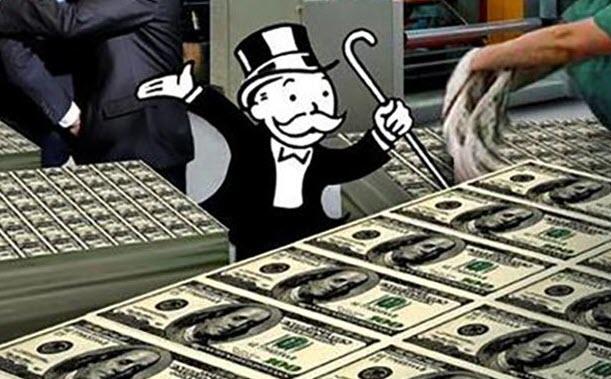Every Federal Reserve Board Member Is A Multi-Millionaire Tyler Durden Tue, 06/23/2020 - 20:05
There are five Senate-confirmed members of the Federal Reserve. It won’t surprise you to know that all five of them are millionaires. Here’s a list, with links to their financial disclosure forms. (If you have some time to poke around and find anything interesting, let me know or put it in the comments.)
-
The Chair, Jay Powell, 67, is worth between $20 million and $55 million, the richest Fed Chair in history.
-
Randal Quarles, 62, is worth between $24.7 million and $125 million.
-
Richard H. Clarida, 63, is worth between $9 million and $39 million.
-
Michelle Bowman, 49, is worth between $2 million and $11 million.
-
Lael Brainaird, 58, is worth between $3 million and $11 million.
I’ve gone over the financial disclosure forms of all five of these members, and they are all invested in various forms of indexes. Some are invested in private equity funds, Blackrock iShares, or various other assets referencing financial corporations. These strike me as a violation of Section 10, part 5 of the Federal Reserve Act, which says:
No member of the Board of Governors of the Federal Reserve System shall be an officer or director of any bank, banking institution, trust company, or Federal Reserve bank or hold stock in any bank, banking institution, or trust company;
It’s been decades since anyone took conflicts of interest seriously, and I suspect that the Fed has lawyers who can weasel their way into ensuring that Fed board members get to invest in the financial services industry without violating this law. But the statute is there for a reason, which is that the Fed was created in 1913 to take power from Wall Street banks, not to place them on a publicly sanctioned monetary throne. (The original House passed version of the Federal Reserve Act had the Secretary of Agriculture as a Fed Governor, because farmers were the main labor force and borrowing group in the economy back then.)
There’s a more fundamental problem with the arrangement of having an all-millionaire Fed board, aside from any pecuniary gain that might result from all members of the Fed having public positions in which their policy decisions affect their portfolios in similar ways. The Fed is supposed to manage lending and borrowing conditions, but the only people represented among decision-makers are lenders, as opposed to a balance of lenders and borrowers.
America is full of people with credit card debt, student debt, auto debt and medical debt, people who have had trouble getting jobs, or people with bad credit, or entrepreneurs who can’t get loans to build their businesses. Young people. Old people. Middle-aged people, of different races. Yet the Fed board is composed of those with graduate degrees and high net worths, most of whom are in their late 50s or early 60s in terms of age.
In other words, based on their asset ownership and educational credentials alone, no one on the Fed is in touch with the world in which most Americans live. My analysis actually understates the problem, because there are members of the key policy committee at the Fed, known as the Federal Open Markets Committee, that aren’t even appointed by the President and confirmed by the Senate, but are hired by regional bankers to run Fed branches. (I’m not kidding. It was actually a brief flashpoint during the debate over post-financial crisis legislation, whether bankers could continue to hire their own regulators. Barney Frank’s compromise was that they could.)
This lack of representation has serious consequences. In 2017, I reported on how key Fed policymakers mocked unemployed Americans behind closed doors, laughing at and making jokes about them as lazy drug addicts. People didn’t want jobs, according to several officials, one of whom based his commentary on what his wife had told him about her charity work.
These rigid members had to debate Fed board member Sarah Bloom Raskin, who had gone, undercover, to a job fair, to see how employment conditions were on the ground. She was shocked at the poor quality of job offerings, despite what appeared to be a solid economy. Raskin’s undercover attendance at a job fair caused a bit of a stir, because it was a violation of decorum; Fed members simply don’t do such things. Her view, unsurprisingly, was that the Fed should see unemployment as a function of the bad economy, not poor work ethic. I don’t know if anyone on the FOMC has gone to a job fair since Raskin did. But the stack of old millionaires on the board suggests there’s a serious imbalance in terms of representation; there are more private equity barons on the Fed board than people with student debt.
One of the main policy problems in America is that political elites seem to over-prioritize the stock market. It’s not just an inequality problem, but even broader than that. For instance, no one in power really took the Coronavirus seriously until the market started tanking in March. One of the main reasons for this is that policymaking increasingly flows through the Federal Reserve, and the people who run the place have social networks and portfolios that are dependent on how Wall Street is doing, not how the rest of America is.
Anyway, one of my dream pieces of legislation would be a law that reserves half of the slots on the Federal Reserve board for non-millionaires. I know such a law seems gimmicky, but representation really does matter. At least one person on the Fed board should know what it’s like to be harassed by a debt collector, instead of owning financial assets whose value depends on the people doing the harassing.
https://ift.tt/2Vebsvl
from ZeroHedge News https://ift.tt/2Vebsvl
via IFTTT


0 comments
Post a Comment